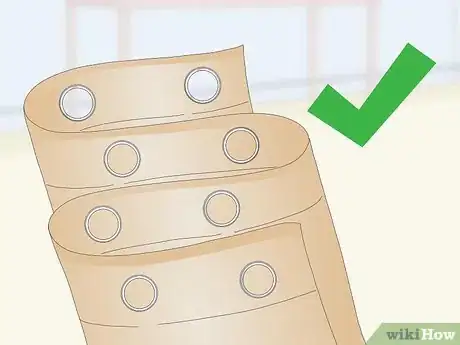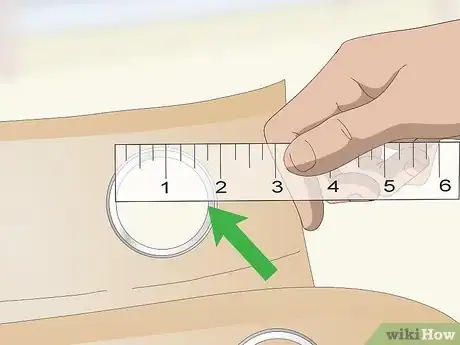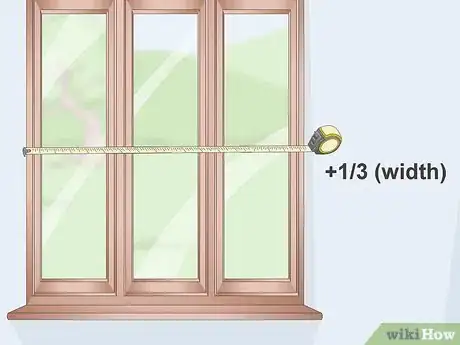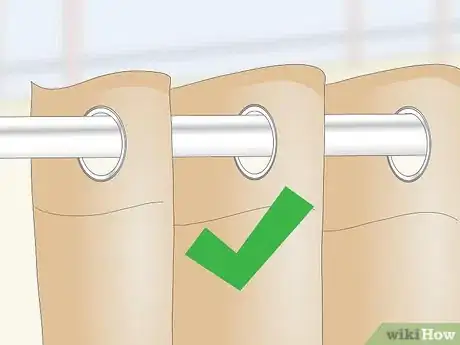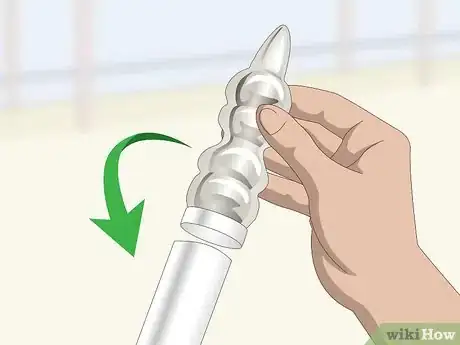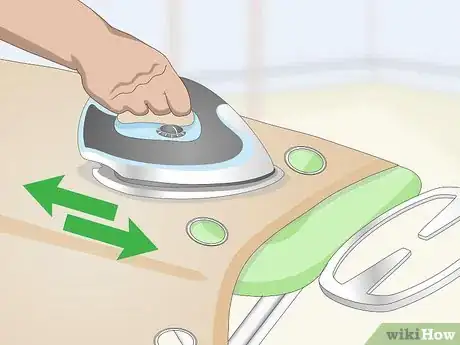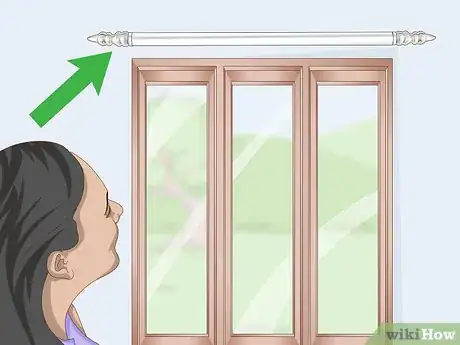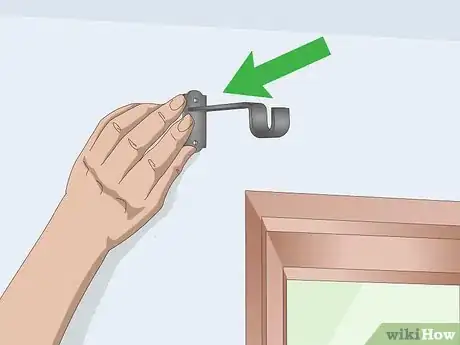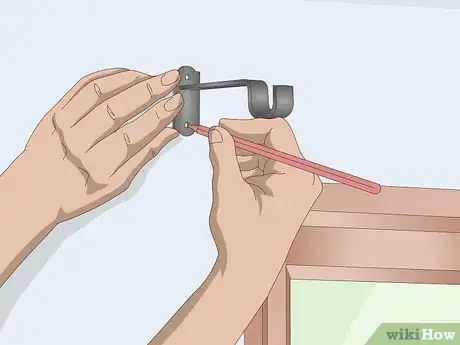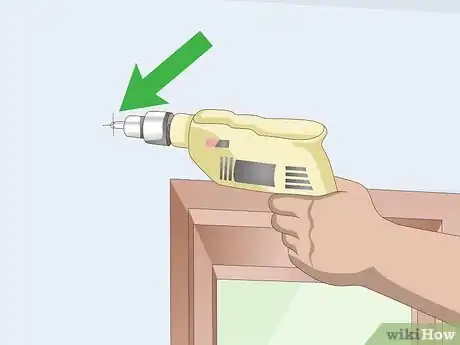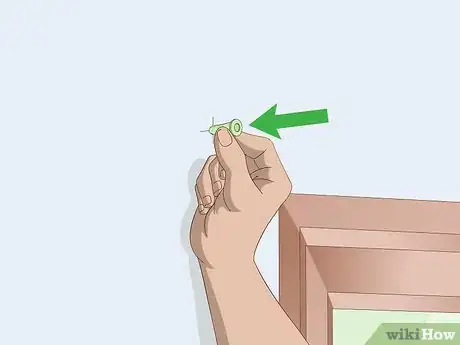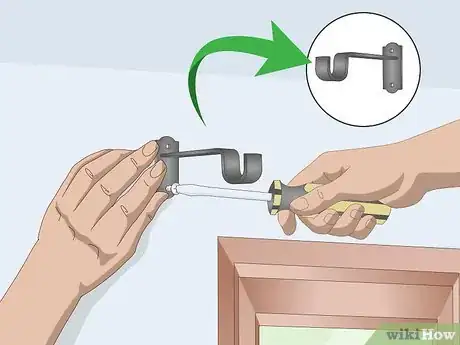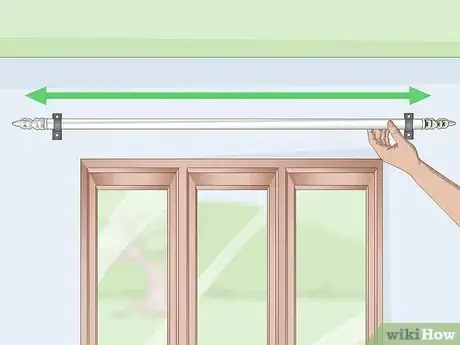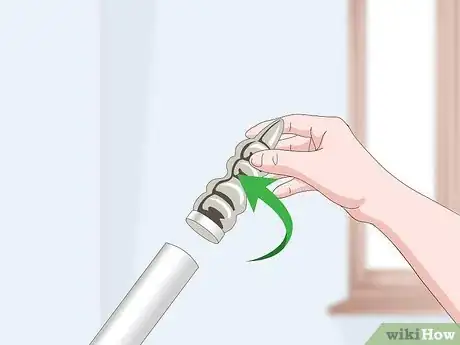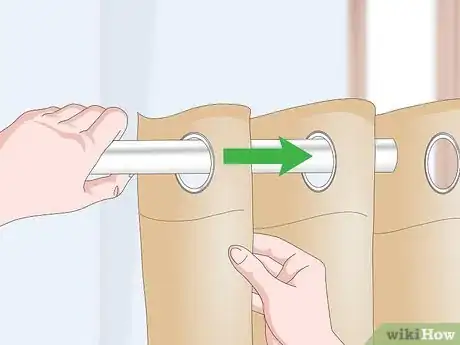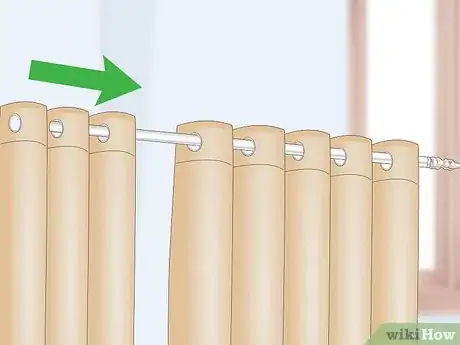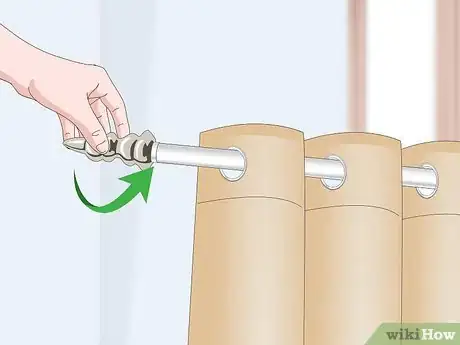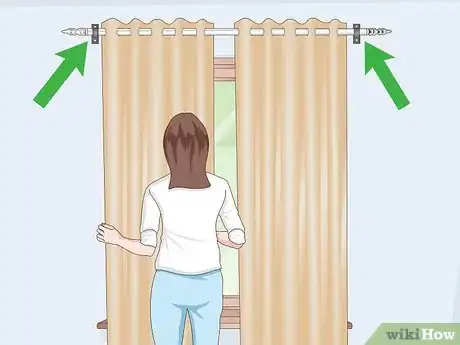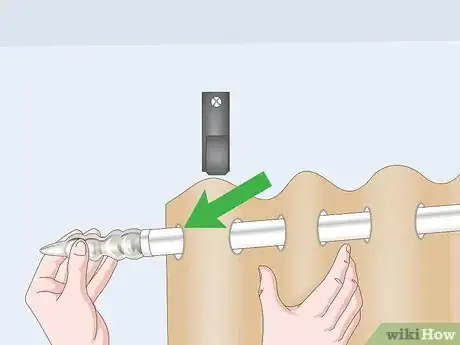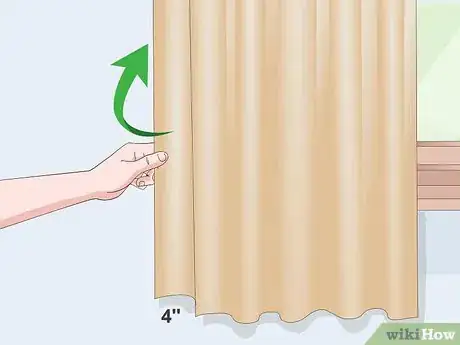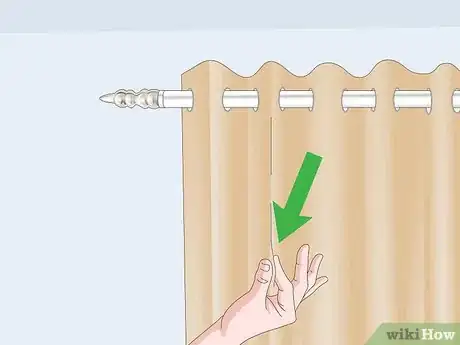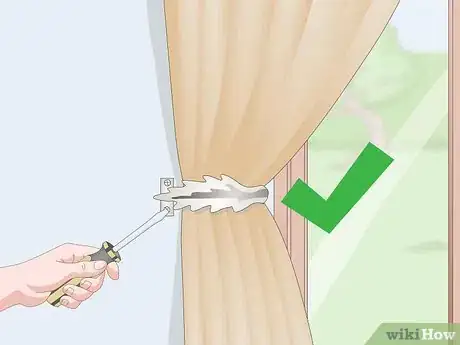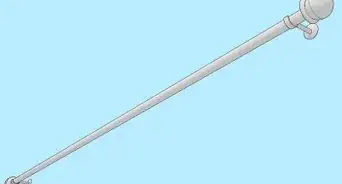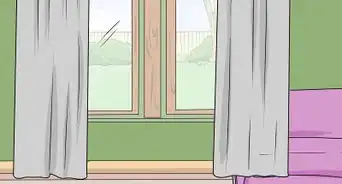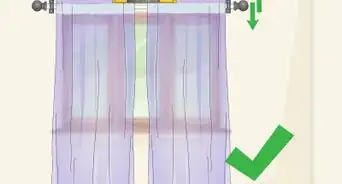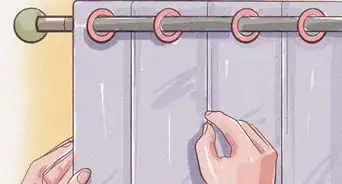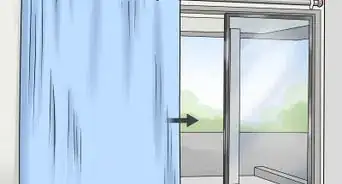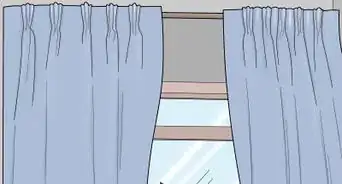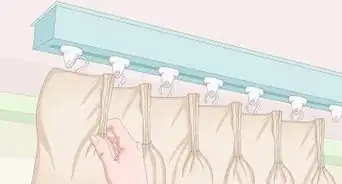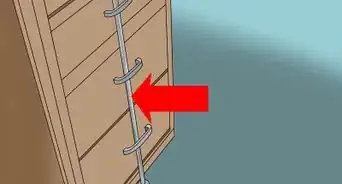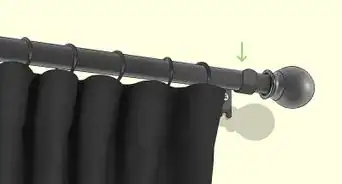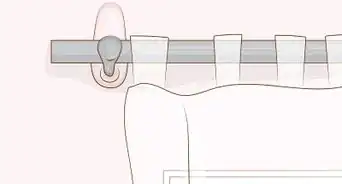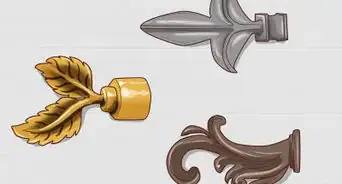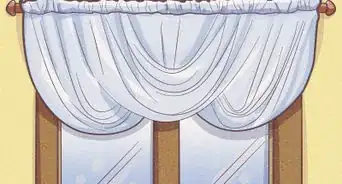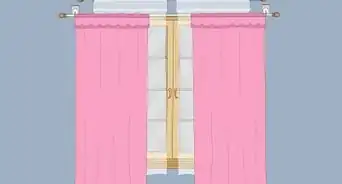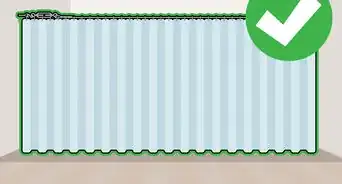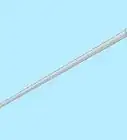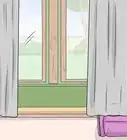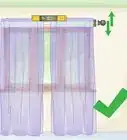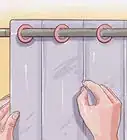This article was co-authored by Angelica Savard. Angelica Savard is a Home Stager, Realtor, and Interior Designer based in Long Beach, California. She is also the Co-owner of Elegant Domain Interiors LLC, a business that offers design consulting, home staging, and window treatments. She has over 15 years of interior design and consulting experience. She earned a BA from California State University Long Beach with an emphasis on Interior Architectural Design.
There are 7 references cited in this article, which can be found at the bottom of the page.
This article has been viewed 86,460 times.
Eyelet curtains, also referred to as "grommet curtains," have holes along the top edge. These holes are finished with large grommets to prevent fraying and present a nicer finish. They are easy to install and do not require curtain rings. The way that they are woven onto a curtain rod creates beautiful folds in the fabric, which can make just about any room appear more grand and formal.
Steps
Buying Your Curtains and Rod
-
1Buy a set of eyelet curtains with an even number of grommets. This is very important, because the number of grommets affects the way that you thread the curtain onto the rod. If the curtain has an odd number of eyelets, the edges of the curtain won't lay properly against the wall.
- Match the color and style of the curtains to the room that you are hanging them in.
-
2Find out or measure the inside width of the grommets.[1] The rod you buy needs to be thin enough to slide through the curtain's grommets. Most rods should be thin enough to do this, but it wouldn't hurt to get the exact measurements. Check the packaging that your curtains came in. If you can't find the grommet size on the label, use a ruler to measure the inside width on 1 of the grommets.
- If you don't want to measure, a rod with a width between 1 3⁄8 to 1 1⁄2 inches (3.5 to 3.8 cm) will probably work for most eyelet curtains.
Advertisement -
3Measure your window to determine the rod length you need. Measure across your window first.[2] Multiply your measurement by 1/3, then add the answer back to your measurement. This will give you the length of the curtain rod. For example, if your rod is 54 inches (140 cm):
- 54 x 1/3 = 18
- 18 + 54 = 72
- Final curtain rod length: 72 inches
-
4Buy a curtain rod that's the right length and matches the grommets. The rod should be the same shade and color as the grommets on your curtain. It should also small enough to slide through them. If the length you need falls between 2 standard sizes, choose the larger size.[3]
- Matching the shade is important. A light silver rod won't look good against dark silver grommets.
- Check the label when buying the curtain rod. Some measurements include the finials while others don't. You need to look at the measurement without the finials.
-
5Buy matching finials for the rod, if needed. Finials are the ornamental stoppers on both ends of a curtain rod. They prevent the curtains from sliding off the rod. Many curtain rods already come with these. If your curtain rod doesn't come with them, buy them separately, but make sure that they match.
-
6Iron the curtains from the front if they are creased. Read the washing instructions to find out what temperature setting you should use on the iron—or if you can iron the fabric in the first place.
- An alternative to ironing is steaming the curtains with a steamer.
- If you can't iron or steam the curtains, drape the curtains across your bed for several hours up to an entire day. This will help relax any creases.[4]
Installing the Brackets
-
1Decide where you want to mount the curtain.[5] In general, brackets are mounted 4 to 6 inches (10 to 15 cm) above the window frame, and about 3 inches (7.6 cm) to either side of it. You can deviate from these measurements if you want to alter the proportions of your window. For example:
- If you want your window to appear taller, place the brackets 8 inches (20 cm) above the window, or closer to the ceiling or crown molding.[6]
- If you want your window to appear wider, place the brackets 3 to 6 inches (7.6 to 15.2 cm) from the sides of the window.
-
2Place the bracket against the wall where you want it to hang. Use a ruler to measure up and to the side of the window first. Next, place the bracket against the wall where you measured to. Place a level on top of the bracket to make sure that it is straight and not crooked.[7]
- Where you measure to depends on where you want the bracket to hang. Refer to the previous step for guidance.[8]
- The bubble on the level should be centered between the guidelines on the tube. If the bubble is off-center, tilt the bracket until the bubble is centered.
-
3Use a pencil to create guide marks for the drill holes. Stick a sharpened pencil through 1 of the screw holes, and wiggle it around to create a mark. Repeat this step for the other screw holes on the bracket.
-
4Drill holes into the wall using the pencil marks as guides. Set the brackets aside first, then use a drill to make holes in the walls, right over the pencil marks you made. You need to drill the holes first without the brackets, otherwise you risk chipping the wall's surface.[9]
-
5Insert wall anchors into the hole if you don't have a wooden stud. Wooden studs help anchor screws into walls. If you don't have a wooden stud behind the hole, you should insert a wall anchor into the hole first.[10]
- If you aren't sure about the studs, pick up a stud finder tool at a home improvement store. They're cheap and can prevent you from mistakenly hanging the curtains without a stud to support them.
- Make sure that the wall anchors can hold the weight of the rod and the curtains.
-
6Replace the bracket and insert the screws, then do the other brackets. Hold the bracket against the wall. Insert a screw into 1 of the holes, then drill it into place. Do the remaining holes on the bracket before moving onto the second bracket. Remember to measure and mark the placement first before drilling into the wall and installing each bracket.
-
7Set the rod onto the brackets, then adjust the length, if needed. Some curtain rods are sold at a set length, while others are adjustable. Take your final rod measurement from the previous section, and adjust the rod to that length. Make sure that you have an equal amount of extension on both sides of the window.
Attaching the Curtain to the Rod
-
1Remove 1 of the finials from the curtain rod. Take the curtain rod off the brackets first, then unscrew 1 of the finials. Set the finial aside some place where you won't lose it.[11]
-
2Weave the curtain rod through the grommets, starting from the front. Turn the curtain so that the front/right side is facing you. Slide the curtain rod down through the first grommet and up through the next one. Continue weaving until the rod comes out of the last grommet.
- It is very important that you start weaving from the front of the curtain. If you start from the back, the edges won't lay right.
-
3Repeat the process with the second panel, if needed. If you will only have 1 panel on your curtain rod, you are done and can proceed to the next step. If you will have 2 panels, repeat the previous step. Make sure that you slide the second panel in the same way, starting from the front of the curtain.
-
4Screw the finial back onto the curtain. Shift the curtain down the rod so that it doesn't get caught. Place the finial back onto the rod, and screw it back into place, just like you would screw a cap onto a bottle.[12]
-
5Place the curtain rod onto the brackets. Your curtain is now ready to use. There are a few more steps that you can take to make the presentation even nicer. They are not absolutely necessary, but they can really update your room and make the curtains drape nicely.
Adding the Final Touches
-
1Move the curtain so that the outer grommets are outside the brackets. Lift the left side of the curtain rod and slide the curtain so that the first grommet is on the outside of the bracket. Set the rod back down, and repeat this step with the last grommet on the second panel.[13]
- If you want to be able to move the curtain panel back-and-forth across the entire rod, the last grommet should be inside the bracket.[14]
- If your curtain has just 1 panel, do this step with the first and last grommets.
-
2Fold the returns inside the curtain, if needed. The return is the excess 4 inches (10 cm) or so of fabric on each side of the curtain panel. Not all curtains have this, but if yours does, tuck the excess fabric into the curtain to that it rests against the wall. This will give your curtain a nicer finish.[15]
- If the return won't stay inside the curtain, insert a drapery pin to the back of the return. Place a screw into the wall, then secure the pin to the screw.
-
3Adjust the folds on the curtain, if needed. Eyelet curtains develop natural folds because of the way that they are hung. If your curtains didn't get these folds, open the curtains up. Run your fingers down them from top-to-bottom, placing your fingers into the folds.
-
4Install tie back brackets, if desired. Eyelet curtains typically don't need to be tied back because of the way that they drape, but you can certainly install wall-mounted tie backs if you want to. Measure two-thirds down from the top of the window frame. Place the tie back bracket against the wall and mark the holes with a pencil. Remove the bracket and drill the holes. Replace the bracket and insert the screws.[16]
- You can also tie back the curtains using ropes or ribbon.
Community Q&A
-
QuestionI want to have my curtains hanging away from the window unless closed. Can I do this?
 Itz_ReginaCommunity AnswerYes, you can. The easiest way to do that is to have something to keep them to the side, but make sure they don't get stuck. You can also just use ribbons to tie them to a hook.
Itz_ReginaCommunity AnswerYes, you can. The easiest way to do that is to have something to keep them to the side, but make sure they don't get stuck. You can also just use ribbons to tie them to a hook. -
QuestionWhat clearance from the floor (carpet) should I give eyelet curtains if they touch? They will drag I think.
 Community AnswerYou could either go to the top of the baseboard or 1" from the floor. If you have pets, then allow at least 1" because they rub into the curtains and sometimes lay right by them, thus making it easy for them to pull down the curtain/s.
Community AnswerYou could either go to the top of the baseboard or 1" from the floor. If you have pets, then allow at least 1" because they rub into the curtains and sometimes lay right by them, thus making it easy for them to pull down the curtain/s. -
QuestionWhen you have a window 8ft (2440) wide and the pole has a centre support bracket, do the curtains close together successfully?
 Community AnswerYes, as the support bracket is thin and about 1/4 inch, especially if you use rings on the top of your curtains/drapes. If you use just material through the rod, it will be harder to close and also might damage your curtains.
Community AnswerYes, as the support bracket is thin and about 1/4 inch, especially if you use rings on the top of your curtains/drapes. If you use just material through the rod, it will be harder to close and also might damage your curtains.
Things You'll Need
- Eyelet curtain (1 to 2 panels)
- Matching curtain rod
- Finials (if not included with rod)
- Wall brackets
- Nails
- Drill
- Pencil
- Level
- Wall anchors (optional)
- Iron or steamer (optional)
References
- ↑ Angelica Savard. Home Stager, Realtor, & Interior Designer. Expert Interview. 30 April 2020.
- ↑ Angelica Savard. Home Stager, Realtor, & Interior Designer. Expert Interview. 30 April 2020.
- ↑ https://www.youtube.com/watch?v=w4fuPAGTL08
- ↑ https://www.lowes.com/n/how-to/hang-curtains-drapes
- ↑ Angelica Savard. Home Stager, Realtor, & Interior Designer. Expert Interview. 30 April 2020.
- ↑ Angelica Savard. Home Stager, Realtor, & Interior Designer. Expert Interview. 30 April 2020.
- ↑ https://www.lowes.com/n/how-to/hang-curtains-drapes
- ↑ Angelica Savard. Home Stager, Realtor, & Interior Designer. Expert Interview. 30 April 2020.
- ↑ https://www.lowes.com/n/how-to/hang-curtains-drapes
- ↑ https://www.lowes.com/n/how-to/hang-curtains-drapes
- ↑ https://homesteady.com/how-6713529-hang-grommet-curtains.html
- ↑ https://homesteady.com/how-6713529-hang-grommet-curtains.html
- ↑ https://homesteady.com/how-6713529-hang-grommet-curtains.html
- ↑ https://www.youtube.com/watch?v=w4fuPAGTL08&feature=youtu.be&t=35s
- ↑ https://www.theshadestore.com/item-files/page_34520_file.pdf
- ↑ https://www.realsimple.com/home-organizing/decorating/curtains-window-treatments#where-shop
- ↑ https://www.realsimple.com/home-organizing/decorating/curtains-window-treatments#where-shop
About This Article
Eyelet curtains are finished with large grommets that make them easy to install without any curtain rings. If you don’t have curtain rod brackets already, use wall anchors to secure them to your wall before hanging your curtains. Place 1 slightly to the left and above your window, and 1 slightly to the right and above the other side of your window. Predrill holes in the wall for the anchors, then screw the wall anchors into the holes of the brackets. Once the brackets are set up, all you have to do is unscrew the stopper on one end of the curtain rod, slide the rod through the grommets, and screw the stopper back in place. Then, you can place the curtain rod on the brackets you installed. To learn how to buy the right curtain rod for your window, read on!
